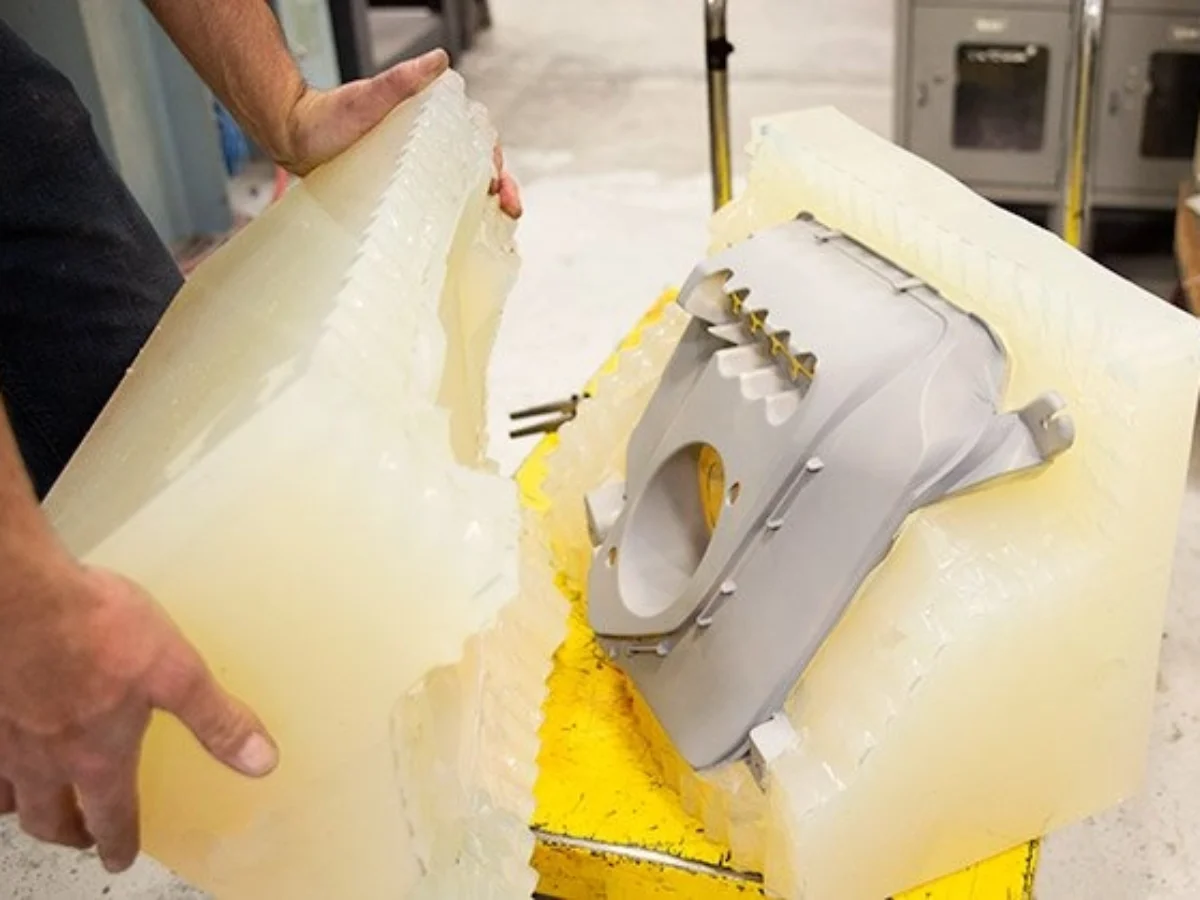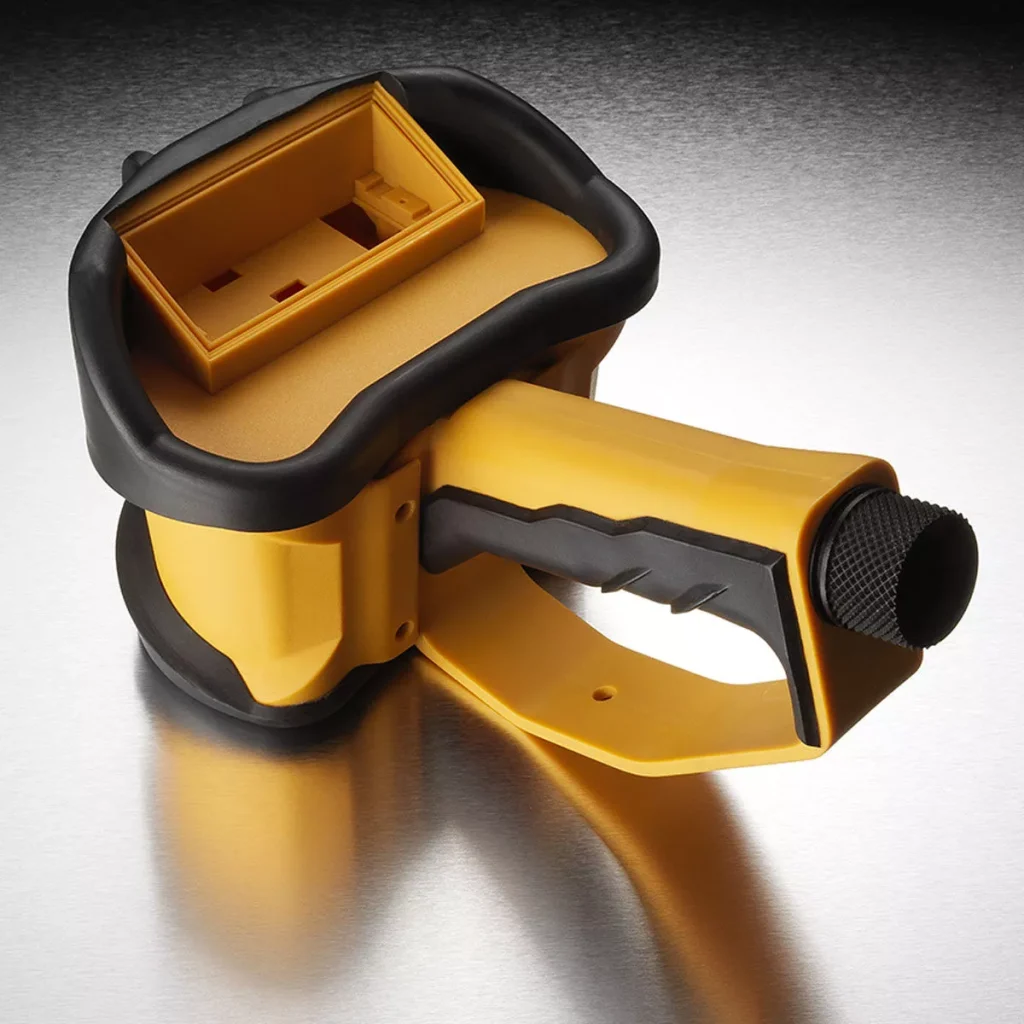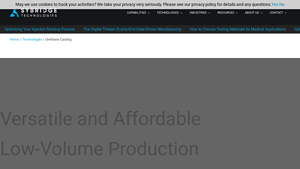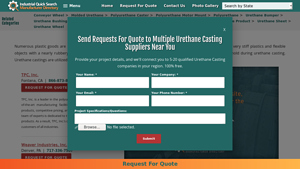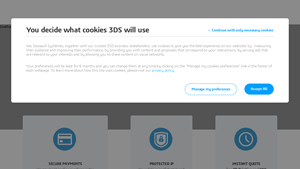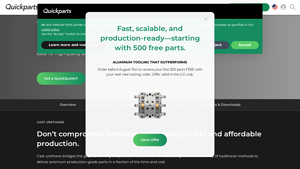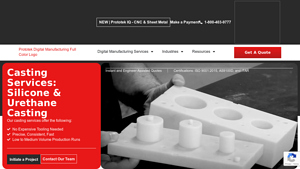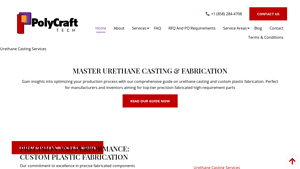Urethane Casting Services Guide: Type, Cost, Top List…
Introduction: Navigating the Global Market for urethane casting services
In today’s fast-paced global market, sourcing high-quality urethane casting services can present significant challenges for B2B buyers, particularly those in emerging regions like Africa, South America, the Middle East, and Europe. The demand for durable, custom parts—ranging from prototypes to low-volume production—requires a nuanced understanding of material properties, supplier capabilities, and cost structures. This comprehensive guide is designed to equip international buyers with the insights necessary to navigate the complexities of urethane casting services effectively.
Within this guide, you will discover a wealth of information covering various types of urethane materials, their applications across industries, and the critical factors to consider when selecting suppliers. We delve into essential topics such as supplier vetting processes, key performance indicators, and pricing strategies that include considerations for tariffs and logistics. By providing actionable insights and expert recommendations, this guide empowers you to make informed purchasing decisions that align with your unique project requirements.
Whether you are in Brazil evaluating the feasibility of a new product line or in Vietnam seeking reliable partners for rapid prototyping, understanding the landscape of urethane casting services is crucial. By leveraging this guide, you can confidently navigate the global market, ensuring that your sourcing decisions lead to successful outcomes and enhanced business performance.
Understanding urethane casting services Types and Variations
| Type Name | Key Distinguishing Features | Primary B2B Applications | Brief Pros & Cons for Buyers |
|---|---|---|---|
| General Purpose Urethane | Impact-resistant, ABS-like properties, Shore D 76-80 | Prototyping, enclosures, and concept models | Pros: Versatile; Cons: Limited temperature resistance. |
| Rigid Clear Urethane | High transparency, matte to glossy finishes, Shore D 80 | Optical components, display models | Pros: Excellent aesthetics; Cons: May require more finishing work. |
| Rubber-Like Polyurethane | High elongation and flexibility, Shore A 25-95 | Seals, gaskets, and soft-touch applications | Pros: Durable and flexible; Cons: Less rigid for structural applications. |
| High-Temperature Urethane | Withstands elevated temperatures, Shore D 78-85 | Automotive, aerospace, and industrial applications | Pros: Heat resistant; Cons: Higher cost than standard urethanes. |
| Medical-Grade Silicone | Biocompatible, high-temperature resistance, Shore A 30-60 | Medical devices, surgical models | Pros: Safe for medical use; Cons: Limited color options. |
What Are the Key Characteristics of General Purpose Urethane Casting Services?
General Purpose Urethane is characterized by its impact resistance and properties similar to ABS plastics, making it suitable for a variety of applications. Its Shore hardness ranges from 76 to 80, providing a balance of strength and flexibility. This type is ideal for prototyping and producing enclosure housings, enabling businesses to develop concept models effectively. When purchasing, consider the specific environmental conditions the parts will face, as this material has limited temperature resistance.
How Does Rigid Clear Urethane Stand Out in Urethane Casting?
Rigid Clear Urethane is notable for its high transparency and versatility in finishes, ranging from matte to glossy. With a Shore hardness of 80, it is perfect for applications requiring aesthetic appeal, such as optical components and display models. Buyers should evaluate the desired finish and clarity, as achieving a high gloss may require additional polishing. While it offers excellent visual properties, the need for post-processing can increase production time and costs.
In What Scenarios Is Rubber-Like Polyurethane Most Beneficial?
Rubber-Like Polyurethane is defined by its high elongation and flexibility, with Shore hardness values between 25 and 95. This makes it particularly useful for applications such as seals and gaskets, where durability and flexibility are essential. When considering this option, businesses should assess the mechanical properties required for their applications. Although it provides excellent flexibility, it may not be suitable for applications requiring rigid structural integrity.
What Advantages Does High-Temperature Urethane Offer for B2B Buyers?
High-Temperature Urethane can withstand elevated temperatures, with Shore hardness ranging from 78 to 85. This material is commonly used in demanding sectors such as automotive and aerospace, where heat resistance is crucial. Buyers should weigh the benefits of durability against the potentially higher costs compared to standard urethanes. It is essential to evaluate the specific temperature ranges the parts will encounter to ensure optimal performance.
Why Choose Medical-Grade Silicone for Specialized Applications?
Medical-Grade Silicone is distinguished by its biocompatibility and high-temperature resistance, with Shore hardness between 30 and 60. This type is specifically designed for use in medical devices and surgical models, ensuring safety and compliance with stringent health regulations. When sourcing this material, businesses must consider its limited color options and the potential need for specialized processing. Its unique properties make it an excellent choice for applications requiring stringent health standards.
Key Industrial Applications of urethane casting services
| Industry/Sector | Specific Application of urethane casting services | Value/Benefit for the Business | Key Sourcing Considerations for this Application |
|---|---|---|---|
| Automotive | Production of custom interior components | Enhances vehicle aesthetics and user experience | Look for suppliers with experience in automotive standards and rapid prototyping capabilities. |
| Medical Devices | Manufacturing surgical models and prototypes | Allows for effective testing and validation of designs | Ensure compliance with medical regulations and availability of biocompatible materials. |
| Consumer Electronics | Creation of enclosures and protective casings | Provides durability and aesthetic appeal | Consider suppliers who offer a variety of finishes and colors to match branding. |
| Aerospace | Fabrication of lightweight structural components | Reduces weight while maintaining strength | Source from companies with expertise in high-performance materials and stringent quality control. |
| Industrial Equipment | Production of seals and gaskets | Improves equipment longevity and performance | Evaluate suppliers on their ability to meet tight tolerances and produce low-volume runs. |
How is Urethane Casting Services Applied in the Automotive Industry?
In the automotive sector, urethane casting services are frequently utilized for the production of custom interior components, such as dashboard panels, trim pieces, and consoles. This method allows for the creation of parts that not only meet aesthetic requirements but also enhance user experience through superior tactile qualities. For international buyers, especially in regions like Africa and South America, sourcing from suppliers who understand local automotive standards and can provide rapid prototyping is crucial. Additionally, the flexibility in design enables manufacturers to quickly adapt to changing market demands.
What Role Does Urethane Casting Play in Medical Device Manufacturing?
Urethane casting is pivotal in the medical device industry, where it is used to manufacture surgical models and prototypes. These prototypes are essential for testing and validating designs before mass production, ensuring that they meet stringent safety and efficacy standards. Buyers in this sector must prioritize suppliers who can guarantee compliance with medical regulations and offer biocompatible materials. This is particularly important for international buyers from the Middle East and Europe, where regulatory frameworks can vary significantly.
How Can Urethane Casting Enhance Consumer Electronics Products?
In the realm of consumer electronics, urethane casting services are employed to create enclosures and protective casings that provide both durability and aesthetic appeal. These components are critical for protecting sensitive electronic devices while also enhancing their visual attractiveness. Businesses should seek suppliers that offer a wide range of finishes and color options to align with their branding needs. This is especially relevant for companies in Europe and South America, where consumer preferences for product design can differ widely.
What Advantages Does Urethane Casting Offer in Aerospace Applications?
The aerospace industry benefits from urethane casting services for the fabrication of lightweight structural components, which are essential for reducing overall vehicle weight while maintaining strength and durability. This application is crucial for enhancing fuel efficiency and performance. When sourcing from suppliers, aerospace companies should focus on those with expertise in high-performance materials and stringent quality control processes. International buyers must also consider the supplier’s ability to navigate complex regulatory environments associated with aerospace manufacturing.
How is Urethane Casting Used in Industrial Equipment?
Urethane casting services are widely applied in the production of seals and gaskets for industrial equipment, significantly improving the longevity and performance of these machines. By providing effective sealing solutions, businesses can reduce maintenance costs and downtime. Buyers should evaluate suppliers based on their ability to meet tight tolerances and produce low-volume runs, which is often necessary for specialized industrial applications. This is particularly important for international buyers in emerging markets who may require tailored solutions to meet specific operational challenges.
3 Common User Pain Points for ‘urethane casting services’ & Their Solutions
Scenario 1: Navigating Cost Efficiency in Low-Volume Production
The Problem:
Many B2B buyers, especially those in emerging markets like Africa and South America, face a significant challenge when it comes to cost efficiency in low-volume production runs. Traditional manufacturing methods, such as injection molding, often require high upfront costs for tooling and setup, which can be prohibitive for companies needing only small quantities. This creates a dilemma: how to obtain high-quality parts without incurring unsustainable costs, particularly when operating under tight budgets.
The Solution:
To overcome this financial hurdle, businesses should consider leveraging urethane casting services, which offer a viable alternative for low-volume production. By utilizing soft tooling techniques with 3D-printed master patterns and RTV silicone molds, companies can significantly reduce initial costs while still achieving production-quality results. Buyers should seek service providers who offer flexible pricing structures and transparent quotes that account for tariffs and shipping, especially when sourcing internationally. Additionally, focusing on suppliers that provide a variety of urethane materials can help in selecting the most cost-effective option that meets specific performance requirements. By requesting samples and prototypes early in the process, businesses can validate quality before committing to larger orders, ensuring both cost efficiency and product reliability.
Scenario 2: Ensuring Product Quality and Consistency
The Problem:
Quality control is paramount for B2B buyers, particularly those supplying industries like automotive or medical devices, where safety and reliability are non-negotiable. Many companies encounter issues with variability in material properties and finish when working with different urethane casting suppliers. This inconsistency can lead to costly reworks, production delays, and, ultimately, damage to the brand’s reputation.
The Solution:
To mitigate quality concerns, buyers should prioritize working with reputable urethane casting service providers that emphasize quality assurance practices. It’s essential to verify that the supplier adheres to strict tolerances and utilizes high-quality materials suited for specific applications. Buyers should request detailed material data sheets and certifications, particularly for medical-grade or high-performance urethanes, to ensure compliance with industry standards. Establishing a close collaboration with the chosen supplier can also facilitate better communication regarding design specifications and quality benchmarks. Setting up periodic reviews and feedback loops during the production process can help catch potential issues early, ensuring that the final products meet the expected standards without compromising delivery timelines.
Scenario 3: Speeding Up Time to Market
The Problem:
In fast-paced industries, time to market can be a crucial competitive advantage. However, B2B buyers often struggle with long lead times associated with traditional manufacturing processes, which can delay product launches and hinder responsiveness to market demands. This is particularly challenging for businesses looking to capitalize on trends or respond to client requests promptly.
The Solution:
To accelerate time to market, businesses should take advantage of the rapid prototyping capabilities offered by urethane casting services. Many providers can deliver first articles in as little as three days, allowing companies to quickly iterate on designs and gather feedback from stakeholders or end-users. Buyers should clearly communicate their timelines and project requirements to the casting service provider, ensuring that they understand the urgency of the request. Utilizing advanced technologies, such as 3D printing for master patterns, can further enhance production speed without sacrificing quality. Additionally, establishing a long-term relationship with a reliable supplier can streamline future projects, as they will be familiar with the company’s specific needs and preferences, enabling faster turnaround times for subsequent orders.
Strategic Material Selection Guide for urethane casting services
What Are the Key Properties of Common Urethane Casting Materials?
Urethane casting services utilize various materials, each with distinct properties that influence their suitability for specific applications. Understanding these materials is crucial for international B2B buyers aiming to optimize their product performance and manufacturing processes.
Polyurethane (General Purpose)
Key Properties: Polyurethane is a thermoset material known for its excellent impact resistance, durability, and versatility. It typically exhibits a Shore hardness ranging from 76 to 80, making it suitable for a variety of applications.
Pros & Cons: The primary advantages of general-purpose polyurethane include its cost-effectiveness and ability to mimic the properties of common thermoplastics. However, it may not withstand extreme temperatures or harsh chemicals, which can limit its use in certain environments.
Impact on Application: Polyurethane is widely used for enclosures, concept models, and other applications where a balance of strength and flexibility is required. It is compatible with various media but may degrade in the presence of strong solvents.
Considerations for International Buyers: Compliance with international standards such as ASTM or DIN is essential when selecting polyurethane materials. Buyers from regions like Africa and South America should also consider local availability and import regulations.
Rigid Clear Polyurethane
Key Properties: This material offers high transparency and a Shore D hardness of around 80. It is particularly noted for its optical clarity, making it ideal for applications requiring visibility.
Pros & Cons: The main advantage of rigid clear polyurethane is its aesthetic appeal, which is crucial for consumer-facing products. However, its rigidity may limit its use in applications requiring flexibility, and it can be more expensive than standard polyurethane.
Impact on Application: Rigid clear polyurethane is often used in lenses, cosmetic models, and protective covers. Its clarity allows for visual inspection of internal components, which is beneficial in many industries.
Considerations for International Buyers: Buyers must ensure that the material meets specific optical standards, especially in regions with stringent quality requirements. Understanding the local market for clear materials is also vital for cost management.
Rubber-Like Polyurethane
Key Properties: This elastomeric material has a Shore A hardness ranging from 25 to 95, providing a high degree of flexibility and elongation at break.
Pros & Cons: Rubber-like polyurethane is known for its excellent abrasion resistance and elasticity, making it suitable for applications requiring durability under stress. However, it may not perform well under high temperatures or in environments with harsh chemicals.
Impact on Application: Common uses include seals, gaskets, and soft-touch surfaces. Its flexibility allows for better fitting and sealing in mechanical assemblies, enhancing product performance.
Considerations for International Buyers: Buyers should be aware of the specific mechanical properties required for their applications and ensure compliance with relevant standards. Additionally, sourcing rubber-like materials may be challenging in certain regions, necessitating a reliable supply chain.
Glass-Filled Nylon-Like Urethane
Key Properties: This high-performance material mimics glass-filled nylon, offering a Shore D hardness of 85 and high impact strength, along with a high heat deflection temperature (HDT).
Pros & Cons: The key advantage of glass-filled nylon-like urethane is its strength and durability, making it ideal for demanding applications. However, the complexity of manufacturing and higher costs may deter some buyers.
Impact on Application: It is often used in structural components and high-stress applications where mechanical strength is critical. This material is particularly effective in environments requiring high thermal resistance.
Considerations for International Buyers: Understanding the specific mechanical and thermal properties required for applications in different industries is crucial. Compliance with international standards and certifications can also impact sourcing decisions.
Summary Table of Urethane Casting Materials
| Material | Typical Use Case for urethane casting services | Key Advantage | Key Disadvantage/Limitation | Relative Cost (Low/Med/High) |
|---|---|---|---|---|
| Polyurethane (General Purpose) | Enclosures, concept models | Cost-effective and versatile | Limited temperature and chemical resistance | Medium |
| Rigid Clear Polyurethane | Lenses, cosmetic models | High optical clarity | Limited flexibility | High |
| Rubber-Like Polyurethane | Seals, gaskets, soft-touch surfaces | Excellent abrasion resistance and elasticity | Poor performance under high temperatures | Medium |
| Glass-Filled Nylon-Like Urethane | Structural components, high-stress applications | High strength and durability | Higher manufacturing complexity and cost | High |
In-depth Look: Manufacturing Processes and Quality Assurance for urethane casting services
What Are the Key Stages in the Urethane Casting Manufacturing Process?
Urethane casting involves a series of well-defined stages that ensure the production of high-quality, durable parts suitable for various applications. Here’s a breakdown of the primary steps in the manufacturing process:
How Is Material Prepared for Urethane Casting?
The initial stage involves selecting and preparing the appropriate urethane materials. Manufacturers typically use polyurethane or silicone, which can be tailored to achieve specific properties such as hardness, flexibility, and durability. The preparation process includes measuring and mixing the raw materials according to precise specifications to ensure consistency. This mixture is then degassed to eliminate air bubbles, which could compromise the final product’s integrity.
What Techniques Are Used in the Forming Stage?
Once the materials are ready, the next step is forming the parts. This is accomplished through a method known as “soft tooling,” where 3D-printed master patterns and RTV (room temperature vulcanizing) silicone molds are utilized. This technique allows for rapid prototyping and low-volume production without the high costs associated with traditional metal tooling. The mixed urethane is poured into the molds, where it cures and takes shape, forming the desired part.
How Does the Assembly Process Work in Urethane Casting?
After curing, the cast parts are removed from the molds and may undergo an assembly process if required. This could involve integrating additional components such as inserts or fasteners to enhance functionality. The assembly stage is critical for ensuring that the final product meets the design specifications and performance requirements.
What Finishing Techniques Are Commonly Employed?
The final stage of the manufacturing process is finishing, which includes surface treatment options such as painting, polishing, or applying textures. Depending on the application, finishes can range from matte to high-gloss or textured surfaces. This step not only enhances the aesthetic appeal but also contributes to the part’s functionality, such as reducing glare or improving grip.
How Is Quality Assurance Integrated into Urethane Casting?
Quality assurance (QA) is a crucial aspect of urethane casting services, ensuring that every part produced meets the required standards and specifications.
What International Standards Guide Urethane Casting Quality Assurance?
To maintain high-quality standards, many manufacturers adhere to international quality management systems such as ISO 9001. This standard outlines the criteria for establishing a quality management system and emphasizes customer satisfaction through consistent product quality. Additionally, industry-specific certifications like CE marking for safety or API standards for oil and gas components may apply, depending on the end-use of the urethane parts.
What Are the Key Quality Control Checkpoints in Urethane Casting?
Quality control (QC) is typically structured around several checkpoints throughout the manufacturing process:
-
Incoming Quality Control (IQC): This step involves inspecting raw materials upon arrival to ensure they meet specified criteria before production begins.
-
In-Process Quality Control (IPQC): During manufacturing, continuous monitoring is conducted to identify any deviations from established quality standards. This includes checking the mixture of materials and monitoring the curing process.
-
Final Quality Control (FQC): After production, each part undergoes a thorough inspection to assess its dimensions, surface finish, and overall quality. This ensures that the final product aligns with the customer’s specifications and international standards.
Which Testing Methods Are Commonly Used in Urethane Casting Quality Assurance?
Common testing methods in the urethane casting industry include:
-
Dimensional Inspection: Using calipers and gauges to verify that parts meet specified dimensions and tolerances.
-
Mechanical Testing: Assessing properties such as tensile strength, hardness, and flexibility through standardized tests.
-
Visual Inspection: Conducting a visual assessment for surface defects, color consistency, and overall appearance.
How Can B2B Buyers Verify Supplier Quality Assurance?
For B2B buyers, particularly those operating in regions like Africa, South America, the Middle East, and Europe, ensuring a supplier’s adherence to quality standards is vital. Here are actionable steps buyers can take:
What Should Buyers Look for in Supplier Audits and Reports?
Buyers should request audits and quality assurance reports from potential suppliers. These documents should detail the supplier’s compliance with international standards and any industry-specific certifications. A supplier’s history of passing audits can be a strong indicator of their commitment to quality.
How Can Third-Party Inspections Enhance Confidence in Quality?
Engaging third-party inspection services can provide an unbiased assessment of a supplier’s quality control processes. These inspections can occur at various stages of production, offering additional assurance that the products meet the required standards.
What Nuances Should International Buyers Consider Regarding Quality Control?
International B2B buyers must be aware of the nuances in quality control that can vary by region. For instance, some regions may have stricter regulations regarding material safety and environmental impact. Understanding these differences is crucial for ensuring compliance and avoiding potential legal issues.
Additionally, buyers should consider the logistical challenges of sourcing materials and products from different regions. Clear communication regarding quality expectations and delivery timelines can help mitigate risks and ensure a smoother procurement process.
Conclusion
Understanding the manufacturing processes and quality assurance protocols for urethane casting services is essential for B2B buyers seeking reliable suppliers. By familiarizing themselves with the key stages of production, quality checkpoints, and verification methods, international buyers can make informed decisions that align with their operational needs and standards. This knowledge not only enhances procurement strategies but also fosters successful partnerships with suppliers across the globe.
Practical Sourcing Guide: A Step-by-Step Checklist for ‘urethane casting services’
Introduction
Navigating the procurement of urethane casting services can be complex, especially for international B2B buyers. This guide provides a practical checklist to streamline your sourcing process, ensuring you secure high-quality services that meet your specific needs. By following these steps, you can enhance your decision-making and optimize your investment in urethane casting solutions.
Step 1: Define Your Technical Specifications
Clearly articulating your project requirements is the foundation of successful sourcing. Identify critical factors such as material type, hardness (Shore A/D ratings), dimensions, tolerances, and production volume. This clarity will help you communicate effectively with potential suppliers and ensure they understand your expectations.
- Consider the end-use of the parts to select appropriate materials.
- Specify any special finishes or colors needed for the final product.
Step 2: Research Potential Suppliers
Invest time in researching suppliers that specialize in urethane casting services. Look for companies with proven experience in your industry, as this can indicate their capability to meet your standards.
- Check their websites for case studies and customer testimonials.
- Use platforms like LinkedIn or industry forums to gather insights from past clients.
Step 3: Evaluate Supplier Capabilities
Before committing, it’s crucial to vet suppliers thoroughly. Request company profiles, technical capabilities, and relevant certifications, such as ISO standards. This assessment will help ensure that the supplier can deliver on your quality and timeline requirements.
- Inquire about their production processes and technology.
- Assess their flexibility in handling various order sizes, from prototypes to larger runs.
Step 4: Request Samples and Prototypes
Obtaining samples or prototypes is an essential step to verify the quality of the supplier’s work. This allows you to assess the materials, finishes, and overall craftsmanship before placing a larger order.
- Specify the exact materials and specifications for the samples.
- Use this opportunity to evaluate their responsiveness and customer service.
Step 5: Verify Quality Control Processes
Understanding a supplier’s quality control measures is vital to ensuring consistent product quality. Ask about their testing procedures, inspection protocols, and how they handle defects or issues that arise during production.
- Look for suppliers who offer detailed documentation of their quality assurance processes.
- Ensure they have a clear method for addressing and resolving customer complaints.
Step 6: Negotiate Terms and Pricing
Once you’ve identified a suitable supplier, discuss terms and pricing. Be clear about your budget, and don’t hesitate to negotiate based on your volume and long-term potential as a client.
- Request a detailed quote that breaks down costs, including materials, labor, and shipping.
- Discuss payment terms and any warranties or guarantees offered.
Step 7: Establish a Communication Plan
Effective communication is critical throughout the project lifecycle. Set expectations for regular updates, feedback loops, and points of contact to facilitate smooth collaboration.
- Determine the preferred channels of communication (email, phone, etc.).
- Schedule regular check-ins to monitor progress and address any emerging concerns.
By following this checklist, you can confidently navigate the sourcing process for urethane casting services, ensuring that your final products meet the highest standards of quality and performance.
Comprehensive Cost and Pricing Analysis for urethane casting services Sourcing
What Are the Key Cost Components in Urethane Casting Services?
Understanding the cost structure of urethane casting services is essential for B2B buyers. The major cost components typically include:
-
Materials: The choice of urethane or silicone materials directly impacts the overall cost. Different grades and properties, such as Shore hardness and thermal resistance, can vary significantly in price. Specialty materials, like medical-grade silicones or high-impact resins, will typically incur higher costs.
-
Labor: Skilled labor is required for the precise manufacturing and finishing of cast parts. Labor costs may vary based on the complexity of the project and the region of sourcing. Automation can reduce labor costs, but the initial investment might be higher.
-
Manufacturing Overhead: This includes expenses related to facility maintenance, equipment depreciation, and utilities. Overhead costs can fluctuate based on location and operational efficiency.
-
Tooling: Unlike traditional injection molding, urethane casting employs soft tooling, which is generally less expensive. However, the cost of creating 3D-printed master patterns and RTV silicone molds should be factored in, particularly for custom designs.
-
Quality Control (QC): Ensuring parts meet required specifications incurs additional costs. Rigorous testing and certification processes, especially for industries like aerospace or medical, can add to the price.
-
Logistics: Transportation costs can vary based on distance and shipping methods, especially for international buyers. Understanding Incoterms is vital to avoid unexpected fees.
-
Margin: Suppliers will typically include a profit margin, which can vary widely based on their market position and the perceived value of their services.
How Do Volume and Customization Impact Urethane Casting Pricing?
Pricing for urethane casting services is significantly influenced by order volume and the level of customization required.
-
Volume/MOQ: Generally, suppliers have no minimum order quantity (MOQ), making it cost-effective for low-volume production. However, pricing per unit tends to decrease with larger orders due to economies of scale. Buyers should negotiate pricing based on projected volumes to leverage better rates.
-
Specifications and Customization: Customized parts, including specific dimensions, finishes, or unique material properties, will typically incur higher costs. Providing detailed specifications can help suppliers offer more accurate quotes.
What Quality and Certification Factors Should Buyers Consider?
Quality certifications can be crucial, especially for industries with stringent regulations. Buyers should inquire about:
-
Material Certifications: Ensure that materials meet relevant industry standards, such as FDA approval for medical applications.
-
Process Certifications: ISO certifications or compliance with specific industry standards can indicate a supplier’s commitment to quality and reliability.
What Are the Best Negotiation Strategies for International Buyers?
B2B buyers, particularly from Africa, South America, the Middle East, and Europe, should consider several strategies:
-
Research and Compare: Understand the market rates by comparing multiple suppliers. This information can be used as leverage during negotiations.
-
Long-Term Relationships: Establishing a long-term partnership can lead to better pricing and terms over time. Suppliers may be more willing to negotiate if they see potential for ongoing business.
-
Total Cost of Ownership (TCO): Consider not just the upfront costs but also factors like shipping, potential delays, and quality issues that could incur additional expenses down the line.
What Pricing Nuances Should International Buyers Be Aware Of?
International buyers should be mindful of several nuances that could affect pricing:
-
Tariffs and Duties: Import taxes can significantly impact the final cost. Understanding these can help in budget planning.
-
Currency Fluctuations: Exchange rates can change, affecting overall costs. Locking in prices or using hedging strategies can mitigate this risk.
-
Supplier Location: Proximity to suppliers can reduce logistics costs and lead times. However, balancing this with quality and reliability is crucial.
Disclaimer on Indicative Prices
Prices for urethane casting services can vary widely based on the factors discussed above. It is essential for buyers to seek tailored quotes from suppliers to obtain accurate pricing information for their specific needs.
Alternatives Analysis: Comparing urethane casting services With Other Solutions
Introduction: Exploring Alternatives to Urethane Casting Services
In the realm of manufacturing, selecting the right production method is crucial for achieving desired outcomes in terms of quality, cost, and efficiency. Urethane casting services offer a versatile and cost-effective solution for low-volume production, but it’s essential for B2B buyers to consider alternative methods that may better suit their specific needs. This section will compare urethane casting services with two viable alternatives: injection molding and 3D printing.
Comparison Table
| Comparison Aspect | Urethane Casting Services | Injection Molding | 3D Printing |
|---|---|---|---|
| Performance | High-quality parts with excellent surface finish | Superior strength, high-volume production | Good for complex geometries, lower strength |
| Cost | Affordable for low volumes, no MOQ | High upfront costs, economical for large runs | Low setup costs, but material costs can add up |
| Ease of Implementation | Requires minimal tooling and setup | Complex tooling and longer lead times | Quick setup, no tooling required |
| Maintenance | Low maintenance, molds can last for multiple uses | High maintenance for molds, expensive repairs | Minimal maintenance, dependent on printer |
| Best Use Case | Prototyping, low-volume production | High-volume production, durable parts | Rapid prototyping, intricate designs |
Detailed Breakdown of Alternatives
Injection Molding
Injection molding is a traditional manufacturing process that uses high-pressure to inject molten material into a mold. This method excels in producing high-strength parts at scale, making it ideal for large production runs. However, the initial setup costs are significantly higher due to the need for custom molds. This can be a barrier for companies looking to produce low volumes. Additionally, injection molding has longer lead times, as mold design and fabrication can take several weeks. The primary advantage lies in its cost-effectiveness for large quantities, but for low-volume needs, it may not be the most economical choice.
3D Printing
3D printing, or additive manufacturing, has gained popularity for its flexibility and rapid prototyping capabilities. It allows for the creation of complex geometries that are difficult to achieve through traditional methods. The setup costs are relatively low, as there is no need for molds. However, the material costs can be higher, especially for high-quality filaments, and the strength of 3D-printed parts may not match that of those produced through urethane casting or injection molding. 3D printing is best suited for rapid prototyping and custom parts but may not be the ideal choice for high-volume production due to slower production speeds.
Conclusion: Choosing the Right Solution for Your Needs
When evaluating manufacturing solutions, B2B buyers should consider their specific requirements, including production volume, desired part properties, and budget constraints. Urethane casting services provide an excellent middle ground for low-volume production with high-quality results, particularly suited for prototypes and functional testing. In contrast, injection molding is best for high-volume production with durable parts, while 3D printing excels in rapid prototyping and complex designs. Assessing these factors will empower buyers to make informed decisions that align with their operational goals and market demands.
Essential Technical Properties and Trade Terminology for urethane casting services
What Are the Key Technical Properties of Urethane Casting Services?
Understanding the critical specifications involved in urethane casting is essential for B2B buyers looking to make informed decisions. Here are some of the most important properties to consider:
1. Material Grade
Material grade refers to the specific type of polyurethane used in the casting process. Different grades exhibit varying characteristics such as hardness, flexibility, and impact resistance. For example, Shore hardness levels can range from A (soft) to D (hard), indicating the material’s firmness. Selecting the appropriate material grade ensures that the end product meets the specific requirements of its application, whether it’s for consumer goods or industrial components.
2. Tolerance
Tolerance is the allowable deviation from a specified dimension. In urethane casting, tight tolerances, such as ±0.005 inches for the first inch, are crucial for ensuring that parts fit together correctly in assemblies. For B2B buyers, understanding tolerances helps in assessing the quality and precision of the casting service, which can directly impact the performance and reliability of the final product.
3. Shore Hardness
Shore hardness measures the hardness of elastomers and plastics, expressed using the Shore scale. For instance, a Shore D 80 material is more rigid compared to a Shore A 40 material, which is softer and more flexible. This specification is particularly important for applications requiring specific levels of flexibility or rigidity, allowing buyers to choose materials that best fit their product requirements.
4. Minimum Order Quantity (MOQ)
MOQ is the smallest number of units that a supplier is willing to produce or sell. In urethane casting, many manufacturers offer flexible MOQs, allowing buyers to order anywhere from one to several hundred parts. This flexibility is beneficial for companies needing prototypes or small production runs without being burdened by large inventory commitments.
5. Lead Time
Lead time is the period required to complete an order from receipt to delivery. In the context of urethane casting, lead times can be as short as three days for initial prototypes. Understanding lead time is vital for B2B buyers who need to align production schedules with market demands or testing phases, ensuring that they can bring their products to market efficiently.
6. Post-Processing Options
Post-processing refers to additional finishing techniques applied after the casting process, such as painting, polishing, or texturing. These options can enhance the aesthetic and functional properties of the cast parts. B2B buyers should consider post-processing capabilities as they may influence the final appearance and usability of the product.
What Are Common Trade Terms in Urethane Casting Services?
Familiarity with industry jargon can facilitate better communication and negotiation with suppliers. Here are some essential trade terms:
1. Original Equipment Manufacturer (OEM)
An OEM is a company that produces parts or equipment that may be marketed by another manufacturer. Understanding OEM relationships is crucial for buyers who wish to integrate their components with existing systems or products.
2. Request for Quotation (RFQ)
An RFQ is a document sent to suppliers requesting a quote for specific products or services. This term is vital for B2B buyers as it initiates the purchasing process and allows for comparison of pricing and service levels among different suppliers.
3. Incoterms
Incoterms are international commercial terms that define the responsibilities of buyers and sellers in shipping and logistics. Familiarity with these terms helps B2B buyers navigate the complexities of international trade, including costs, risks, and delivery obligations.
4. Rapid Prototyping
Rapid prototyping refers to the quick fabrication of a physical part using 3D CAD data. This term is significant for B2B buyers looking to test designs quickly before committing to full-scale production, enabling iterative design and faster market entry.
5. Bridge Tooling
Bridge tooling is a temporary production method that allows for low-volume production runs while awaiting the final tooling for mass production. This term is important for businesses that require immediate solutions without the high costs associated with permanent tooling.
Incorporating these technical properties and trade terms into your procurement strategy can enhance decision-making and foster effective partnerships in the urethane casting industry.
Navigating Market Dynamics and Sourcing Trends in the urethane casting services Sector
What Are the Current Market Dynamics and Key Trends in Urethane Casting Services?
The urethane casting services market is experiencing significant growth driven by several global factors, including the increasing demand for rapid prototyping and low-volume production across various industries. This trend is particularly pronounced in the automotive, aerospace, and consumer goods sectors, where companies are seeking flexible manufacturing solutions that allow for quick iterations and design modifications. As international B2B buyers from regions such as Africa, South America, the Middle East, and Europe seek to streamline their supply chains, urethane casting emerges as a cost-effective alternative to traditional injection molding, especially for projects requiring fewer than 500 units.
Emerging technologies such as 3D printing and advanced materials are enhancing the capabilities of urethane casting services. These technologies facilitate the creation of intricate designs and allow for a wider range of material properties, including high-temperature and high-impact resins. Additionally, the rise of digital platforms for sourcing and quoting parts is making it easier for global buyers to access and compare services, leading to increased competition among suppliers. Buyers are now empowered to make informed decisions based on quality, lead times, and pricing, which can vary significantly across different providers.
How Can Sustainability and Ethical Sourcing Impact Urethane Casting Services?
Sustainability is becoming an integral part of the sourcing strategy for B2B buyers in the urethane casting services sector. The environmental impact of manufacturing processes is under scrutiny, prompting companies to evaluate their supply chains for sustainability. This includes choosing suppliers who prioritize eco-friendly practices and materials, such as those that utilize recycled or bio-based polyurethanes.
Ethical sourcing is equally crucial as companies strive to ensure that their suppliers adhere to fair labor practices and environmental regulations. Certifications like ISO 14001 for environmental management and the use of ‘green’ materials can serve as benchmarks for buyers looking to partner with reputable casting service providers. By focusing on sustainability and ethical sourcing, businesses not only enhance their brand reputation but also contribute to broader environmental goals.
How Has Urethane Casting Services Evolved Over Time?
The evolution of urethane casting services can be traced back to the early adoption of polyurethane materials in the manufacturing sector. Initially used for its durability and versatility, the technology has advanced significantly, incorporating innovations such as soft-tooling methods and 3D-printed master patterns. These advancements have made urethane casting an attractive option for prototyping and low-volume production, offering high-quality results without the need for expensive molds.
As industries continue to demand faster turnaround times and more flexible production capabilities, urethane casting services have adapted to meet these needs, providing solutions that align with modern manufacturing practices. Today, the sector is positioned at the intersection of technology and sustainability, making it a vital component of the global supply chain for various industries.
Frequently Asked Questions (FAQs) for B2B Buyers of urethane casting services
-
How do I select the right urethane casting supplier for my project?
When choosing a urethane casting supplier, evaluate their experience, capabilities, and material options. Look for companies that provide detailed technical data sheets and examples of previous work. Assess their ability to meet your specific requirements, such as tolerances, lead times, and customization options. Additionally, check for certifications relevant to your industry, such as ISO standards, and consider their geographical location to mitigate potential shipping delays or tariffs. -
What is the typical lead time for urethane casting services?
Lead times for urethane casting services can vary significantly depending on the complexity of the part and the supplier’s capabilities. Generally, first articles can be produced in as little as three days, while full production runs may take two weeks or more. Suppliers often provide expedited services for urgent projects, so it’s essential to communicate your timeline clearly during the initial consultation. -
Are there minimum order quantities (MOQs) for urethane casting?
Most urethane casting suppliers do not impose a minimum order quantity, allowing you to order as few as one part. This flexibility is particularly beneficial for businesses needing rapid prototypes or small production runs. However, larger orders may benefit from economies of scale, potentially reducing the cost per unit. Always confirm the specific policies with your chosen supplier. -
What customization options are available for urethane cast parts?
Urethane casting services offer extensive customization options, including material selection, color matching, and surface finishes. You can choose from various hardness levels, from rigid to flexible, and add features such as texturing or high-gloss finishes. Discuss your specific needs with the supplier to ensure they can accommodate your requirements, including any unique design elements or functional specifications. -
What payment terms should I expect when sourcing urethane casting services?
Payment terms for urethane casting services can vary by supplier, but many expect a deposit upfront, with the balance due upon completion or delivery. It’s common for international transactions to require additional documentation, such as letters of credit or bank guarantees. Clarify payment options and terms during the negotiation phase to avoid any misunderstandings later in the process. -
How do I ensure quality assurance in urethane casting?
To ensure quality assurance, select a supplier that adheres to stringent quality control processes. Inquire about their inspection methods, including dimensional checks and material testing. Request samples or first articles for review before full production begins. Additionally, consider suppliers who offer post-production services like surface finishing or assembly, as these can enhance the overall quality of the final product. -
What are the logistics considerations for international shipping of urethane cast parts?
When sourcing urethane casting services internationally, consider shipping logistics, including lead times, customs clearance, and potential tariffs. Work with suppliers who have experience in international shipping to navigate these complexities effectively. Ensure that your supplier provides clear shipping terms, including Incoterms, to understand who is responsible for various costs and risks during transportation. -
How can I mitigate risks when sourcing urethane casting services from overseas?
Mitigating risks involves thorough supplier vetting, including checking references and reviewing past projects. Consider starting with a small initial order to evaluate the supplier’s capabilities and communication efficiency. Ensure that the supplier provides clear documentation and contracts outlining specifications, timelines, and payment terms. Additionally, using a third-party inspection service can help verify quality before shipment, providing an added layer of security for your investment.
Important Disclaimer & Terms of Use
⚠️ Important Disclaimer
The information provided in this guide, including content regarding manufacturers, technical specifications, and market analysis, is for informational and educational purposes only. It does not constitute professional procurement advice, financial advice, or legal advice.
While we have made every effort to ensure the accuracy and timeliness of the information, we are not responsible for any errors, omissions, or outdated information. Market conditions, company details, and technical standards are subject to change.
B2B buyers must conduct their own independent and thorough due diligence before making any purchasing decisions. This includes contacting suppliers directly, verifying certifications, requesting samples, and seeking professional consultation. The risk of relying on any information in this guide is borne solely by the reader.
Top 6 Urethane Casting Services Manufacturers & Suppliers List
1. Sybridge – Urethane Casting Services
Domain: sybridge.com
Registered: 2003 (22 years)
Introduction: Urethane Casting Services: Versatile and affordable low-volume production with rapid turnaround, high reliability, and consistency. Key capabilities include tight tolerances (0.005 inches for the first inch, 0.003 inches per linear inch thereafter), no minimum order quantity (1 to 500 parts), and high efficiency (35+ shots per mold). Extensive material options include high-temperature and high-imp…
2. Molded Urethane – Urethane Casting Solutions
Domain: molded-urethane.com
Registered: 2001 (24 years)
Introduction: Urethane casting, also known as polyurethane casting (PU), is a flexible manufacturing process that uses urethane carbamate links to create both stiff and flexible plastic goods. It involves injecting polyurethane and additive resins into flexible silicone elastomer molds, making it suitable for low-volume, short-run products like custom models or movie props. Key manufacturers include TPC, Inc., …
3. Dassault Systèmes – Urethane Casting Service
Domain: 3ds.com
Registered: 1995 (30 years)
Introduction: Urethane Casting Service offered by Dassault Systèmes® 3DEXPERIENCE Make is an On-Demand Manufacturing platform connecting designers with industrial 3D printing service providers. The service is primarily used for prototyping or small series production. Key features include: a network of expert manufacturers, hundreds of material options, secure payments, protected intellectual property, and an in…
4. QuickParts – Cast Urethane Services
Domain: quickparts.com
Registered: 1997 (28 years)
Introduction: Cast Urethane Services provide high-quality, cost-effective low volume production runs. Key features include:
– No-compromise quality with options for rigid rubber and tough plastics that meet industry standards.
– Fast turnaround with 3D printing and molds for quick delivery without sacrificing quality.
– Precision with minimal shrinkage and consistent dimensions, backed by 35 years of experience…
5. Prototek – Silicone & Urethane Casting Services
Domain: prototek.com
Registered: 1996 (29 years)
Introduction: Casting Services: Silicone & Urethane Casting. Key features include: No Expensive Tooling Needed, Precise, Consistent, Fast Low to Medium Volume Production Runs. Certifications: ISO 9001:2015, AS9100D, and ITAR. In-house services include 3D Printing, CNC Machining, Urethane Casting, and Sheet Metal Fabrication. The process involves uploading a CAD file, production, quality control, and shipping. S…
6. PolyCraft Tech – Urethane Casting & Custom Plastic Fabrication
Domain: polycrafttech.com
Registered: 2023 (2 years)
Introduction: PolyCraft Tech offers Urethane Casting and Custom Plastic Fabrication services tailored for manufacturers. Key offerings include:
– Custom Urethane Casting for geometrically challenging parts.
– Advanced Plastic Fabrications with high precision.
– Quick-turn prototyping and flexible tooling solutions to accelerate product market entry.
– Soft molds for low volume casting.
– CNC machining and over-…
Strategic Sourcing Conclusion and Outlook for urethane casting services
In navigating the complexities of urethane casting services, international B2B buyers stand to gain significant advantages through strategic sourcing. By understanding the diverse material options and the flexibility that urethane casting offers, companies can produce high-quality prototypes and low-volume parts efficiently. This process not only bridges the gap between rapid prototyping and full-scale production but also allows for cost-effective experimentation with material properties and finishes.
As industries across Africa, South America, the Middle East, and Europe continue to innovate, the demand for versatile and reliable casting solutions will only grow. Buyers are encouraged to consider suppliers that offer rapid turnaround times, minimal order quantities, and customizable options to meet their specific needs.
Looking ahead, embracing urethane casting services can be a transformative step for businesses aiming to enhance their product development cycles. By leveraging these capabilities, companies can not only optimize their production processes but also stay ahead in competitive markets. Engage with leading urethane casting providers today to explore how these services can elevate your manufacturing strategies.
